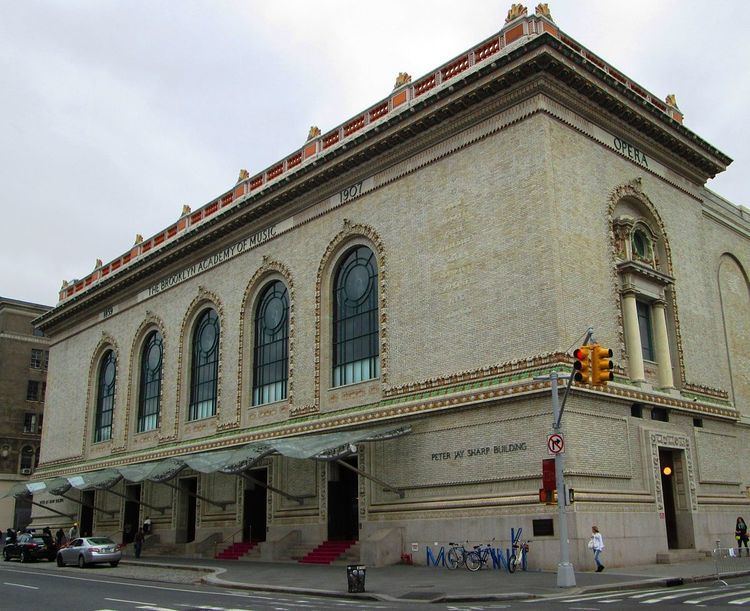Built 1908 Architect Herts & Tallant Phone +1 718-636-4100 | Opened 1908 Capacity 2,983 | |
 | ||
Location 30 Lafayette AvenueBrooklyn, New York City Address 30 Lafayette Ave, Brooklyn, NY 11217, USA Similar Lincoln Center for the Perfor, New York City Opera, Atlantic Theater Company, BRIC, New Museum Profiles | ||
Pete townshend let my love open the door 8 7 1993 brooklyn academy of music official
The Brooklyn Academy of Music (BAM) is a performing arts venue in Brooklyn, New York City, known as a center for progressive and avant garde performance. It presented its first performance in 1861 and began operations in its present location in 1908.
Contents
- Pete townshend let my love open the door 8 7 1993 brooklyn academy of music official
- 19th and early 20th centuries
- 1960spresent
- Architecture
- Performance facilities
- References
Today, BAM has a reputation as a leader in presenting "cutting edge" performance and has grown into an urban arts center which focuses on both international arts presentation and local community needs. Its purpose is to provide an environment in which its audiences – annually, more than 775,000 people – can experience a broad array of aesthetic and cultural programs. From 1999 to 2014, BAM was headed by Karen Brooks Hopkins, President, and Joseph V. Melillo, Executive Producer. Katy Clark is now president, succeeding Hopkins who retired in spring 2015.
19th and early 20th centuries
Founded in 1861, the first BAM facility at 176–194 Montague Street in Brooklyn Heights was conceived as the home of the Philharmonic Society of Brooklyn. The building, designed by architect Leopold Eidlitz, housed a large theater seating 2,200, a smaller concert hall, dressing and chorus rooms, and a vast "baronial" kitchen. BAM presented amateur and professional music and theater productions, including performers such as Ellen Terry, Edwin Booth, Tomas Salvini, and Fritz Kreisler.
After the building burned to the ground on November 30, 1903, plans were made to relocate to a new facility in the then fashionable neighborhood of Fort Greene. The cornerstone was laid at 30 Lafayette Avenue in 1906 and a series of opening events were held in the fall of 1908 culminating with a grand gala evening featuring Geraldine Farrar and Enrico Caruso in a Metropolitan Opera production of Charles Gounod's Faust. The Met would continue to present seasons in Brooklyn, featuring star singers such as Caruso, right through until 1921.
The new building is adjacent to downtown Brooklyn, near the Atlantic Terminal of the Long Island Rail Road and the Williamsburgh Savings Bank Tower, once the tallest building in Brooklyn.
1960s–present
In 1967 Harvey Lichtenstein was appointed executive director and during the 32 years that Lichtenstein was BAM's leader, BAM experienced a renaissance. BAM is now recognized internationally as a progressive cultural center well known for The Next Wave Festival (started in 1983). Artists who have presented their works there include Philip Glass, Peter Brook, Pina Bausch, Merce Cunningham, Laurie Anderson, Lee Breuer, ETHEL, Nusrat Fateh Ali Khan, Steve Reich, Seal, Alice in Chains, Robert Wilson, Peter Sellars, BLACKstreet, Ingmar Bergman, The Whirling Dervishes and the Kirov Opera directed and conducted by Valery Gergiev among others. Lichtenstein gave a home to the Chelsea Theater Center, in residence from 1967–1977.
Architecture
BAM's Peter Jay Sharp Building houses the Howard Gilman Opera House and the BAM Rose Cinemas. It was designed by the firm Herts & Tallant in 1908. It is a "U" shaped building with an open court in the center of the lot between two theater wings above the first story. It measures 190 feet along Lafayette Avenue, 200 feet deep, and 70 feet high. The building has a high base of gray granite with cream colored brick trimmed in terra cotta with some marble detail above. It is located within the Fort Greene Historic District.
Performance facilities
BAM's facilities include:
In the Peter Jay Sharp Building, at 30 Lafayette Avenue:
In the BAM Harvey building, at 651 Fulton Street:
In the Fisher Building, 321 Ashland Place:
The BAM Sharp and Fisher Buildings are located within the Brooklyn Academy of Music Historic District created by the New York City Landmarks Preservation Commission in 1978; the BAM Harvey is not.
